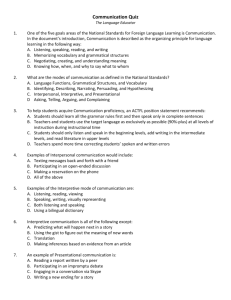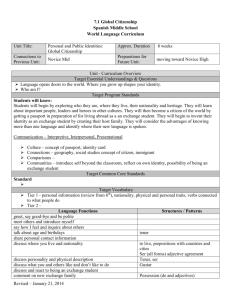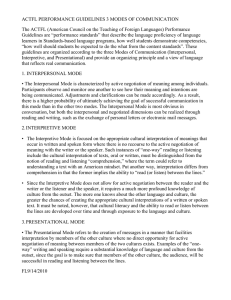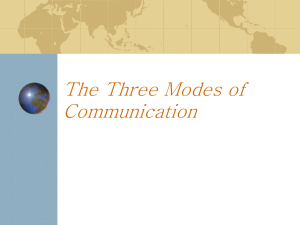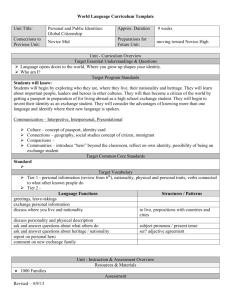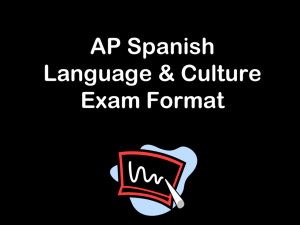AP French Language and Culture
advertisement
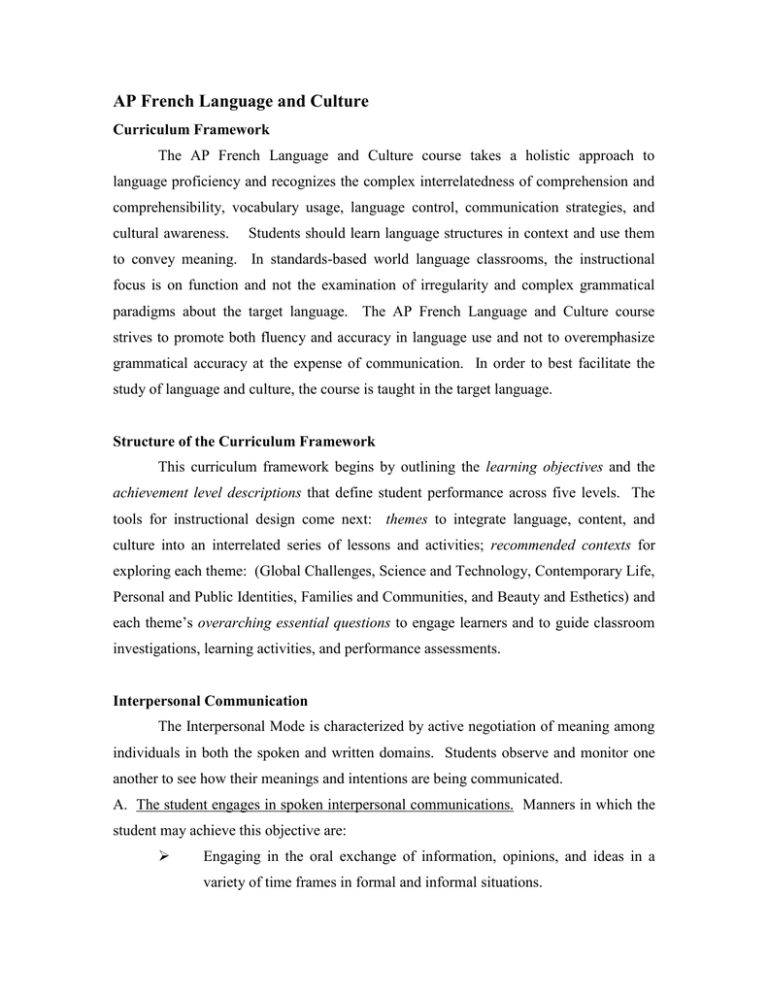
AP French Language and Culture Curriculum Framework The AP French Language and Culture course takes a holistic approach to language proficiency and recognizes the complex interrelatedness of comprehension and comprehensibility, vocabulary usage, language control, communication strategies, and cultural awareness. Students should learn language structures in context and use them to convey meaning. In standards-based world language classrooms, the instructional focus is on function and not the examination of irregularity and complex grammatical paradigms about the target language. The AP French Language and Culture course strives to promote both fluency and accuracy in language use and not to overemphasize grammatical accuracy at the expense of communication. In order to best facilitate the study of language and culture, the course is taught in the target language. Structure of the Curriculum Framework This curriculum framework begins by outlining the learning objectives and the achievement level descriptions that define student performance across five levels. The tools for instructional design come next: themes to integrate language, content, and culture into an interrelated series of lessons and activities; recommended contexts for exploring each theme: (Global Challenges, Science and Technology, Contemporary Life, Personal and Public Identities, Families and Communities, and Beauty and Esthetics) and each theme’s overarching essential questions to engage learners and to guide classroom investigations, learning activities, and performance assessments. Interpersonal Communication The Interpersonal Mode is characterized by active negotiation of meaning among individuals in both the spoken and written domains. Students observe and monitor one another to see how their meanings and intentions are being communicated. A. The student engages in spoken interpersonal communications. Manners in which the student may achieve this objective are: Engaging in the oral exchange of information, opinions, and ideas in a variety of time frames in formal and informal situations. Eliciting information and clarifying meaning by using a variety of strategies. Stating and supporting opinions in oral interactions. Initiating and sustaining interaction through the use of various verbal and nonverbal strategies. Understanding a variety of vocabulary, including idiomatic and culturally appropriate expressions. Using a variety of vocabulary, including idiomatic and culturally appropriate expressions on a variety of topics. Self-monitoring and adjusting language production. Demonstrating an understanding of the features of target culture communities (e.g., geographic, historical, artistic, social, or political). Demonstrating knowledge and understanding of content across disciplines. B. The student engages in written interpersonal communications. Manners in which the student may achieve this objective are: Engaging in the written exchange of information, opinions, and ideas in a variety of time frames in formal and informal situations. Writing formal correspondence in a variety of media using appropriate formats and conventions. Writing informal correspondence in a variety of media using appropriate formats and conventions. Eliciting information and clarifying meaning by using a variety of strategies. Stating and supporting opinions in written interactions. Initiating and sustaining interaction during written interpersonal communication in a variety of media. Understanding a variety of vocabulary, including idiomatic and culturally appropriate expressions. Using a variety of vocabulary, including idiomatic and culturally appropriate expressions on a variety of topics. 2 Self-monitoring and adjusting language production. Demonstrating an understanding of the features of target culture communities (e.g., geographic, historical, artistic, social, or political). Demonstrating knowledge and understanding of content across disciplines. Interpretive Communication The Interpretive Mode is characterized by the appropriate cultural interpretation of meanings that occur in written and spoken form where there is no recourse to the active negotiation of meaning with the writer or speaker. The student synthesizes information from a variety of audio, visual, and audiovisual resources. Manners in which the student may achieve this objective are: Demonstrating comprehension of content from authentic audio, audiovisual, and visual resources. Demonstrating understanding of a variety of vocabulary, including idiomatic and culturally authentic expressions. Understanding the purpose of a message and the point of view of the author. Identifying the distinguishing features (e.g., type of resource, intended audience, purpose) of authentic audio, visual, and audiovisual resources. Demonstrating critical viewing or listening of audio, visual, and audiovisual resources in the target cultural context. Monitoring comprehension and using other sources to enhance understanding. Examining, comparing, and reflecting on products, practices, and perspectives of the target culture(s). Evaluating similarities and differences in the perspectives of the target culture(s) and his or her own culture(s) as found in audio, visual, and audiovisual resources. Demonstrating an understanding of the features of target culture communities (e.g., geographic, historical, artistic, social, or political). Demonstrating knowledge and understanding of content across disciplines. 3 Presentational Communication The Presentational Mode is characterized by the creation of messages in a manner that facilitates interpretation by members of the target culture where no direct opportunity for the active negotiation of meaning exists. The student plans, produces, and presents spoken presentational communications. Manners in which the student may achieve this objective are: Producing a variety of creative oral presentations (e.g., original story, personal narrative, speech, performance). Retelling or summarizing information in narrative form, demonstrating a consideration of audience. Creating and giving persuasive speeches. Expounding on familiar topics and those requiring speech. Using reference tools, acknowledging sources, and citing them appropriately. Self-monitoring and adjusting language production. Demonstrating an understanding of the features of target culture communities (e.g., geographic, historical, artistic, social, or political). Demonstrating knowledge and understanding of content across disciplines. Comparing aspects of a Francophone culture with similar aspects of their own. Authentic Materials As a means to broaden the student’s linguistic and cultural understanding, as well as raise the student’s performance in the target language, a wide variety of authentic, realworld materials will be used. These materials, for example, may be taken from online sources, such as podcasts, news reports, or other video presentations. Additionally, realia from Francophone countries may be used as supplementary information. Examples of this include: train schedules, restaurant menus, or TV listings. The use of all of these 4 sources and materials will help to provide real-world contexts that are both authentic and purposeful. Structural Foundations for Review and Expansion The teacher will decide which language structure(s) may need to be reviewed, depending on the need of the class. The language structures listed below may only be a possible list, depending on the class’s needs. The list is not limited to these structures and the teacher may modify this list, again, depending on the needs of the class. - Nouns, gender, articles - Present tenses and imperative mood - Past tense verbs including passé compose, imperfect and past perfect - Future and conditional verb tenses and clauses - Use and formation of the subjunctive and past subjunctive moods - Use of the infinitive past - Use and formation of the present participle and the gerund - Pronoun complements, stress pronouns - Possessive and demonstrative adjectives and pronouns - Interrogative expressions - Simple and complex relative pronouns - Negation, indefinite and restrictive expressions - Adjectives, adverbs, comparative and superlative - Prepositions and conjunctions Course Materials Textbooks and Reference Sources Ladd, Richard. Allons au-delà! Boston: Pearson, 2012. Ladd, Richard. AP French. Boston: Pearson, 2012. Sturges II, Hale, Linda Cregg Nielsen and Henry Lynn Herbst. Une Fois Pour Toutes. 3rd ed. Boston: Pearson, 2008. 5 Recommended Supplementary Texts Dietiker, Simone Renaud, and Dominique van Hooff. En Bonne Forme. 7th ed. Boston: Houghton Mifflin, 2001 Quarter 1 Theme 1: Global Challenges (Les défis mondiaux) Recommended Contexts: La tolérance, L’économie, L’environnement, La santé, Les droits de l’être humain, L’alimentation, La paix et la guerre Overarching Essential Questions: • What environmental, political, and social issues propose challenges to societies throughout the world? • What are the origins of those issues? • What are possible solutions to those challenges? Learning Objective Evidence Spoken Interpersonal Communication Conversation, Part C, Numéro 10 (AP French) Dialogue/Debate Students will develop a dialogue/debate about a current world event. Students will discuss the problem and propose possible solutions Debate a controversial human right (right to bear arms, freedom of expression, etc.). Discussion Written Interpersonal The advantages and disadvantages of fast-food restaurants: cultural comparison between American restaurants and the rest of the world The most urgent environmental issue facing the world today, its impact, and possible solutions E-mail reply: Part A, Numéros 2, 10 (AP French) Communication Audio, Visual, and Audio visual Interpretive Audio from AP French 6 Communication Audio from http://www.rfi.fr “7 jours sur la planète”, http://www.tv5.org http://www.sos-racisme.org/ Written and Print Interpretive Communication Readings from Allons au-delà: Hergé, Les bijoux de Castfiore Tahar Ben Jalloun, Le racisme expliqué à ma fille Jacques Prévert, Soyez polis Veronique Tadjo, Le dernier espoir Jean-Jacques Rousseau, Du contrat social Declaration des droits de l’homme et du citoyen Emile Zola, Le ventre de Paris Maryse Condé, Haïti, chérie Arthur Rimbaud, Le dormeur du val Paul Eluard, La liberté Jacques Prévert, Familiale Guy Moquet, Lettre de Guy Moquet Selected readings from http://lemonde.fr or other news sources Spoken Presentational Communication AP French Speaking, Part D, Numéros 6, 11, 12, 14, 15 Written Presentational Communication AP French Writing, Part B, Numéros 1, 5 Presentation of current events Essay Discuss a moment where you experienced or witnessed discrimination/racism. How did you respond? How did this experience influence you? Write an essay that explains the ideas of diversity and tolerance to a child. 7 Theme 2: Science and Technology (La science et la technologie) Recommended Contexts: La recherche et ses nouvelles frontières, Les découvertes et les inventions, Les choix moraux, L’avenir de la technologie, La propriété intellectuelle, Les nouveaux moyens de communication Overarching Essential Questions: • How do developments in science and technology affect our lives? • What factors have driven innovation and discovery in the fields of science and technology? • What role do ethics play in scientific advancement? Learning Objective Evidence Spoken Interpersonal Communication Conversation, Part C, Numéro 3 (AP French) Discussion Written Interpersonal The greatest invention of the past century The advantages and disadvantages of an increasingly technological society E-mail reply: Part A, Numéros 4, 7 (AP French) Communication Audio, Visual, and Audio visual Interpretive Communication Audio from AP French Audio from http://www.rfi.fr “7 jours sur la planète”, http://www.tv5.org Written and Print Interpretive Communication Readings from Allons au-delà : Birago Diop, La lance de l’hyène Le Monde, Un appareil qui retranscrit du texte en braille consacré au Concours Lépine Albert Robida et Octave Uzanne, La fin des livres Paris-Match (2009), La mauvaise surprise Kindle Amélie Nothomb, Acide sulfurique L’Express, Tricher au bac comme un geek 8 Articles from Science Actualités, http://www.universcience.fr/fr/science-actualites Spoken Presentational Communication AP French Speaking, Part D, Numéros 4, 10 Oral presentation Written Presentational Communication Students advertise a new invention/technology and respond to questions from prospective buyers AP French Writing, Part B, Numéros 4, 8, 10 Essay A problem or social implication created by technology. Quarter 2 Theme 3: Contemporary Life (La vie contemporaine) Recommended Contexts: La publicité et le marketing, L’éducation, Les fêtes, Le logement, Les loisirs et le sport, Le monde au travail, Les rites de passage Overarching Essential Questions: • How do societies and individuals define quality of life? • How is contemporary life influenced by cultural products, practices and perspectives? • What are the challenges of contemporary life? Learning Objective Evidence Spoken Interpersonal Communication Conversation, Part C, Numéros 1, 2, 4, 5, 6, 7, 9 (AP French) Dialogue/Debate Role-play a conversation between a real estate agent and someone looking to buy a home. Role play a job interview (Allons au-delà, Chapitre 13, Pour communiquer, D) Discussion Written Interpersonal The role of commercials: do they influence what you purchase? Why or why not ? How does your logement influence your way of life? What will be the jobs of the future? What influences the creation of new jobs? What skills will be necessary? E-mail reply: Part A, Numéros 1, 5, 6, 9 (AP French) 9 Communication Audio, Visual, and Audio visual Interpretive Communication Audio from AP French Audio from http://www.rfi.fr Advertisements from various Francophone magazines Contemporary Francophone music and film trailers Film: Entre les murs Readings from Allons au-delà: Written and Print Interpretive Communication Frédéric Beigbeder, 99 Francs Le Monde: Apple introduit le blocage des publicités dans Safari Christiane Rochefort, Les petits enfants du siècle Nathalie Sarraute, L’enfance Qui sont les SDF? Roch Carrier, Le chandail Histoire de la pétanque Readings from En Bonne Forme: Francoise Mallet-Joris, La saga de Daniel Pierre Daninos, La France au Volant Education in Mali: http://www.education.gov.ml Spoken Presentational Communication AP French Speaking, Part D, Numéros 2, 3, 5, 7 Oral Presentation Create and present an advertisement for a new product (Allons au-delà, Chapitre 10, Pour communiquer D) 10 Written Presentational Communication Present your ideal job: what are your responsibilities, challenges, benefits? Un souvenir de voyage (Allons au-delà, Chapitre 15, Pour communiquer, C) AP French Writing, Part B, Numéro 4 Essay What can a young person learn from playing a team sport? Describe a rite of passage that you have experienced. Theme 4: Personal and Public Identities (La quête de soi) Recommended Contexts: L’aliénation et l’assimilation, Les croyances et les systèmes de valeurs, La sexualité, L’identité linguistique, La pluriculturalisme, Le nationalisme et le patriotisme Overarching Essential Questions: • How are aspects of identity expressed in various situations? • How do language and culture influence identity? • How does one’s identity develop over time? Learning Objective Evidence Spoken Interpersonal Communication Conversation, Part C, Numéro 8 (AP French) Dialogue/Debate Debate: FLS- le français langue séconde (Allons au-delà, Chapitre 16, Pour communiquer, E) Debate the French laws about the separation of church and state (“laïcité”, head scarves, religious symbols). Compare this legislation with that in other countries. Discussion Written Interpersonal The effects of immigration: on the individual, on the family, on the nation. Where do your personal values and beliefs originate? Have they changed? What influences them? E-mail reply: Part A, Numéros 3, 8 (AP French) Communication Audio, Visual, and Audio visual Interpretive Communication Audio from AP French Audio from http://www.rfi.fr 11 L’Afrique: 50 ans d’independance: http://independances.tv5monde.com/ Written and Print Interpretive Communication Readings from Allons au-delà: Gabrielle Roy, Vincento Azouz Begag, Béni ou le paradis privé Guy de Maupassant, Aux champs Immigration - Ces étrangères, élèves modèles Jean Arcenaux, Schizophrénie linguistique Faut-il simplifier l’orthographe ? Alphonse Daudet, La dernière classe La République, ses symboles et ses emblèmes Readings from En Bonne Forme: Gisele Halimi, Un cas particulier L’organisation internationale de la Francophonie: http://www.francophonie.org/ Spoken Presentational Communication AP French Speaking, Part D, Numéros 8, 9, 11, 13 Oral Presentation Written Presentational Communication Present what it means to you to be of a certain culture. (To be American, Mexican, Algerian means…to me) Choose an emblem or symbol. Present how it represents that country/culture’s identity, nationalism, and patriotism. AP French Writing, Part B, Numéro 3 Essay If you were to teach a class on American culture for immigrants, what information would you include? How do these themes represent American culture? 12 How does your own language reflect your personality, your beliefs, and your environment? How does language shape one’s identity? Quarter 3 Theme 5 : Families and Communities (La famille et la communauté) Recommended Contexts : Les rapports sociaux, l’enfance et l’adolescence, la citoyenneté, les coutumes, la famille, l’amitié et l’amour Overarching Essential Questions: •What constitutes a family in different societies? •How do individuals contribute to the well-being of communities? •How do the roles that families and communities assume differ in societies around the world? Learning Objective Evidence Spoken Interpersonal Communication Discussion School differences among the US and Francophone countries Debate « Il faut tout un village pour élever un enfant » Allons audelà, p. 310 Dialogue Written Interpersonal Communication Audio, Visual, and Audio visual Interpretive Communication Create and act out a press conference for Prince Charming and Cinderella after they announce their wedding. Incorporate questions of social class difference. Allons au-delà, p. 337 Write a post card or an e-mail to a friend explaining a French holiday that is not widely known in the US, Allons au-delà, p. 323 AP French Part C, Numéros 2, 15, 30 Visual from www.sqf.qc.ca (Québec family initiative) Visual from www.snj.public.lu (Youth services in Luxembourg) Written and Print Interpretive Communication AP French Part A, Numéros 5, 17, 18, 20, 34, 40 Readings from Allons au-delà: 13 Guy de Maupassant, La parure Azouz Bégag, , Le Gone du Chaâba René Goscinny, Le petit Nicolas : On a eu l’inspecteur Leila Sebbar, « Driss » tiré de Shérazade Marcel Pagnol, Le mariage de Manon (tiré de Manon des sources) La Foire de la Sainte-Catherine Charles Perrault, Cendrillon Des enfants adoptés qui s’adaptent bien Spoken Presentational Communication Written Presentational Communication AP French Part D, Numéro 3 Invent a holiday and convince your class why they should celebrate it, Allons au-delà page 323 Write an essay on the influence of family stereotypes in our society. Modernize the story of Tristan and Iseult, Allons au-delà p. 350 Theme 6 : Beauty and Esthetics (L’esthétique) Recommended Contexts : L’architecture, le patrimoine, le beau, les arts littéraires, la musique, les arts de spectacle, les arts visuels Overarching Essential Questions: •How are perceptions of beauty and creativity established? •How do ideals of beauty and aesthetics influence daily life? •How do the arts both challenge and reflect cultural perspectives? Learning Objective Evidence Spoken Interpersonal Communication Discussion Written Interpersonal Communication Compare and contrast American and Francophone rap and its cultural role and impact. In small groups, share opinions of different works of art . E-mail reply Write an email reply to your French Club advisor suggesting music genres, artists and songs from different 14 Audio, Visual, and Audio visual Interpretive Communication Francophone countries to play and discuss at the next meeting. AP French Part C, Numéros 1, 3, 8, 16, 17, 18, 19, 24, 26, 32 Visual and audio: http://webworld.unesco.org/goree (Virtual visit in Sénégal) Written and Print Interpretive Communication AP French Part A, Numéros 3, 7, 8, 10, 24, 26, 31, 32, 35, 36 AP French Part B, Numéro 16 (print and audio) Readings from Allons au-delà : François Villon, L’Epitaphe de Villon ou « Ballade des pendus » Pierre de Ronsard, Mignonne, allons voir si la rose… Jean de la Fontaine, Le corbeau et le renard Paul Verlaine, Il pleure dans mon cœur La Réunion, perle de l’humanité Marguerite Yourcenar, Comment Wang-FÔ fut sauvé Jacques Prévert, Pour faire le portrait d’un oiseau Marguerite Duras, Moderato cantabile Brigitte Baudin, Marion Cotillard : Piaf réincarnée La farce de Maître Pathelin Mémorables Misérables Spoken Presentational Communication AP French Part D, Numéro 1 Oral presentation Written Presentational Communication Create and present a memory capsule, Allons au-delà p. 365 Present a genre of music or song from a Francophone country AP French, Writing Part B, Numéro 2 Write a fable or poem 15 Essay Compare a Jean de la Fontaine fable with that of another author, Allons au-delà p. 366 What role does art play in our world? Allons au-delà p. 379 QUARTER 4 Since the AP exam takes place in early May, the instructor will use this time in order to: conduct French AP examination preparation; if necessary, review and re-enter advanced language structures; and complete the presentation of student-chosen final projects, addressing any one of the six curricular themes. 16
